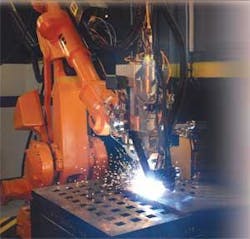Ready for hybrid laser welding?
Ed Hansen
Knowing your product and process will help you arrive at some answers
Maybe you’ve heard the buzz about hybrid laser welding. You’ve heard that this combination of laser and gas metal arc welding (GMAW) can speed the welding process, lower costs, and improve weld quality. But is it right for your application and for your business? Implementing hybrid laser arc welding (HLAW) essentially requires that you rethink your entire fabrication and assembly line. Is it worth it? Is a significant return on investment possible? Let’s look at some of the factors that might determine if HLAW is the process for you.
Hybrid laser welding combines the deep penetration, low heat input, and fast speeds associated with laser welding with the superior gap tolerance and metallurgical control of GMAW. The resulting hybrid process produces deeper weld penetration, lower heat input, less distortion and shrinkage, higher weld toughness and strength, and higher fatigue resistance. Higher welding speeds, 3 to 10 times faster than GMAW or submerged arc welding (SAW), translate into greater productivity and cost efficiency. Additionally, HLAW systems by necessity are fully automated, reducing labor costs, and typically reducing operating costs by one-half or more. HLAW also offers a new method to achieve high-strength welds without a large weld volume, reducing final product weight.
Despite these benefits, HLAW isn’t for everyone. It does require a sizeable capital investment and a commitment to automation. Below are four questions you should ask to determine if HLAW is right for your application.
1. Is your welding process compatible with HLAW?
Consistent edge conditions. HLAW requires the edge profile and surface to remain fairly consistent along the part length and from one part to another. If you have a consistent edge, then the considerations are straightness and fit-up tolerance. For example, an ESAB HLAW system can locate and track a weld joint that varies from its predicted path but the fit-up must be managed closely.
Tolerances. Most HLAW systems tolerate a gap tolerance of less than 0.5mm. Wider gaps can be accommodated by slowing the processes and using larger welds, which defeats the purpose of using HLAW. ESAB produces a system that will actively measure and adapt to a gap tolerance up to 2mm with backing and 1mm without backing. Such systems that can adapt to variations in fit-up sacrifice weld speed and heat input in order to do so. In general, the larger your joint volume, the slower and more heat the process adds to your part. Therefore, this adaptation is done not to enable the use of poor part fit-ups but to achieve greater process robustness without over-welding. To use HLAW, you must be able to achieve good tolerance now or be willing to improve your part cutting and fit up.
Penetration depth. How deep is the required penetration on your application? HLAW can produce penetrations up to ~12.5mm in a single pass (less is easier). Deeper penetrations have been demonstrated in the lab with certain materials, but this is currently the practical limit for commercial systems. Thicker parts can be welded with HLAW in multiple passes using a deep root pass and subsequent capping passes, similar to any conventional fusion process.
Contours. How extensive are the part contours? HLAW is currently appropriate only for welding on straight lines, rotated parts, or gradual curves. The accuracy of most motion and control systems at high travel speeds prevents the use of HLAW on complex geometries without slowing the process. Fortunately, if your parts have relatively simple geometries, the process is then compatible with a wide variety of mechanizations, including gantries, manipulator/positioner systems, column and boom systems, robots and hard-automation systems.
2. Is your application compatible with automation?
HLAW is probably a good option if your process is already automated or mechanized. If you have not yet automated but are considering it, your application should have a high duty cycle with repeatable products or processes.
Industries that generally offer the types of application for which HLAW is ideal include: shipbuilding and marine construction, general transportation, rail, truck, military vehicles, mobile equipment, steel mills, pipe and tube mills, petrochemical, energy, civil infrastructure, automotive, appliance, food and medical equipment, tanks and pressure vessels, and construction materials such as beams, shapes, tubes, and trusses.
HLAW is particularly effective in welding large, thin metal structures, exotic alloys, high-yield materials, stainless steels, and high precision products. It is ideal in high-volume production settings or applications producing high-finish products. It is also excellent in applications with very high-quality inspection requirements or requiring deep penetration, multi-pass welds.
3. Are you a good candidate for automation and HLAW?
To be a good candidate for HLAW, you should have sufficient professional and technical staff to oversee the process. You must be capable of operating and maintaining precision computer-controlled equipment. You must also have staff competent in developing welding processes, inspecting and recognizing weld characteristics, and managing quality output from the HLAW system. Ideally you already have automated equipment or are planning to automate in the near future. Many of the changes you must make for HLAW are the same kinds of changes required for any automated welding process. You must have good control of your part fabrication processes and, perhaps most importantly, you must have a driving need to improve your process and your business.
4. Is it good business to invest in HLAW systems?
Before investing in an HLAW system, you should do a systematic evaluation of your return on investment. You need to feel confident that the substantial investment you are about to make will yield a good return in a relatively short time. Can you afford the initial high capital investment? Do you really need to improve your welding operations and how willing are you to do what it takes to achieve that improvement? Will you benefit from the effects that HLAW has on a manufacturing process? Is there an ROI for HLAW within your operation? How do you know? What do you consider?
Here are some things that should go into building a business case for HLAW:
Increased throughput. Can you achieve a high duty cycle welding process? Can your upstream and downstream operations handle the full output of an HLAW system? Could you sell more products if you could produce it? If an HLAW system could produce three to five times as much as a single welding station in your current plant, what could you do with that liberated floor space? The additional gross margin on increased plant throughput can often achieve very rapid returns on an HLAW investment.
Reduced welding labor. Is your operation currently manual, mechanized, or fully automated? How large is the current workforce, including welders, mechanics and assemblers, material handlers, grinders, and laborers? Do you have difficulty attracting and keeping skilled welders? Many companies today face automating their welding processes simply because they cannot attract and retain skilled welders. This is becoming a matter of survival that can be more significant than the financial return on investment.
The HLAW welding system by necessity is fully automated. It can reduce the number of workers on some processes to a single machine operator. Because HLAW is clean and safe, a job operating an HLAW machine is likely to be more attractive to young workers than traditional welding.
Reduced downstream labor costs. Is distortion a major cost driver? How much time and cost do you put into post-weld straightening and stress relieving? How about post-weld layout, machining, drilling, assembly adjustments, make-up pieces, slotted fasteners, etc.? How much time goes into finishing treatments, grinding, leveling, filling, etc.? HLAW is a low-distortion joining process that can reduce or eliminate non-value-added work, rework, and repair. Applications of HLAW in European shipbuilding, for example, have been demonstrated to eliminate the need for thermal straightening of decks and bulkheads, typically an expensive and high-skill requirement. HLAW can also allow you to shift substantial work back to first operations where it is cheapest to perform. How much time and money can you save by eliminating secondary operations?
Improved product quality. Is improved product quality a selling point for your product? HLAW provides a higher overall fit and finish quality, with reduced or eliminated visible buckling and distortion and very smooth, consistent weld geometries. Will a better quality product or more attractive product help you make more sales? In addition, designers can take advantage of the unique capabilities of HLAW to produce products with lower weight and higher stiffness and strength. Hybrid welds can also achieve longer fatigue life, with quantified and documented weld quality. If product quality provides opportunities for premium margins and barriers to low-tech competitors, HLAW is a process that can deliver.
Conclusion
HLAW is an excellent tool to increase throughput, improve product quality, reduce distortion, reduce labor costs, and create better products more easily. But implementing HLAW requires considerable thought and a real dedication to improving your product and process. Manufacturers of HLAW systems can help you look at the potential benefits as well as the potential impact to your current processes. Is it worth it? Only you can decide.
Ed Hansen ([email protected]) is senior product manager for hybrid welding at ESAB Welding & Cutting Products (Florence, SC; www.esab.com).



